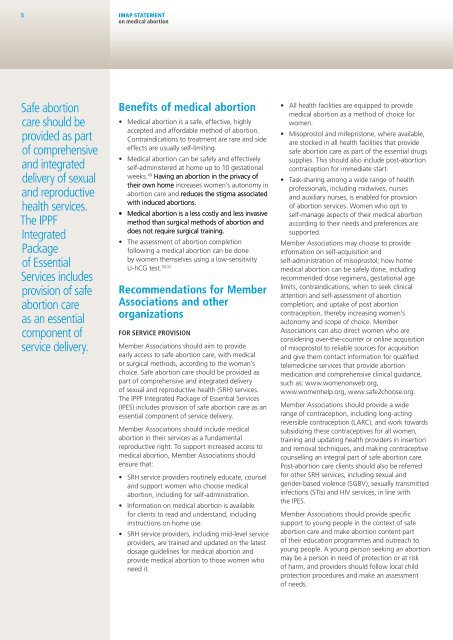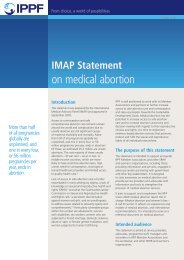ippf_imap_medical abortion
Create successful ePaper yourself
Turn your PDF publications into a flip-book with our unique Google optimized e-Paper software.
5 IMAP STATEMENT<br />
on <strong>medical</strong> <strong>abortion</strong><br />
Safe <strong>abortion</strong><br />
care should be<br />
provided as part<br />
of comprehensive<br />
and integrated<br />
delivery of sexual<br />
and reproductive<br />
health services.<br />
The IPPF<br />
Integrated<br />
Package<br />
of Essential<br />
Services includes<br />
provision of safe<br />
<strong>abortion</strong> care<br />
as an essential<br />
component of<br />
service delivery.<br />
Benefits of <strong>medical</strong> <strong>abortion</strong><br />
• Medical <strong>abortion</strong> is a safe, effective, highly<br />
accepted and affordable method of <strong>abortion</strong>.<br />
Contraindications to treatment are rare and side<br />
effects are usually self‐limiting.<br />
• Medical <strong>abortion</strong> can be safely and effectively<br />
self‐administered at home up to 10 gestational<br />
weeks. 49 Having an <strong>abortion</strong> in the privacy of<br />
their own home increases women’s autonomy in<br />
<strong>abortion</strong> care and reduces the stigma associated<br />
with induced <strong>abortion</strong>s.<br />
• Medical <strong>abortion</strong> is a less costly and less invasive<br />
method than surgical methods of <strong>abortion</strong> and<br />
does not require surgical training.<br />
• The assessment of <strong>abortion</strong> completion<br />
following a <strong>medical</strong> <strong>abortion</strong> can be done<br />
by women themselves using a low‐sensitivity<br />
U‐hCG test. 50,51<br />
Recommendations for Member<br />
Associations and other<br />
organizations<br />
FOR SERVICE PROVISION<br />
Member Associations should aim to provide<br />
early access to safe <strong>abortion</strong> care, with <strong>medical</strong><br />
or surgical methods, according to the woman’s<br />
choice. Safe <strong>abortion</strong> care should be provided as<br />
part of comprehensive and integrated delivery<br />
of sexual and reproductive health (SRH) services.<br />
The IPPF Integrated Package of Essential Services<br />
(IPES) includes provision of safe <strong>abortion</strong> care as an<br />
essential component of service delivery.<br />
Member Associations should include <strong>medical</strong><br />
<strong>abortion</strong> in their services as a fundamental<br />
reproductive right. To support increased access to<br />
<strong>medical</strong> <strong>abortion</strong>, Member Associations should<br />
ensure that:<br />
• SRH service providers routinely educate, counsel<br />
and support women who choose <strong>medical</strong><br />
<strong>abortion</strong>, including for self‐administration.<br />
• Information on <strong>medical</strong> <strong>abortion</strong> is available<br />
for clients to read and understand, including<br />
instructions on home use.<br />
• SRH service providers, including mid‐level service<br />
providers, are trained and updated on the latest<br />
dosage guidelines for <strong>medical</strong> <strong>abortion</strong> and<br />
provide <strong>medical</strong> <strong>abortion</strong> to those women who<br />
need it.<br />
• All health facilities are equipped to provide<br />
<strong>medical</strong> <strong>abortion</strong> as a method of choice for<br />
women.<br />
• Misoprostol and mifepristone, where available,<br />
are stocked in all health facilities that provide<br />
safe <strong>abortion</strong> care as part of the essential drugs<br />
supplies. This should also include post‐<strong>abortion</strong><br />
contraception for immediate start.<br />
• Task‐sharing among a wide range of health<br />
professionals, including midwives, nurses<br />
and auxiliary nurses, is enabled for provision<br />
of <strong>abortion</strong> services. Women who opt to<br />
self‐manage aspects of their <strong>medical</strong> <strong>abortion</strong><br />
according to their needs and preferences are<br />
supported.<br />
Member Associations may choose to provide<br />
information on self‐acquisition and<br />
self‐administration of misoprostol; how home<br />
<strong>medical</strong> <strong>abortion</strong> can be safely done, including<br />
recommended dose regimens, gestational age<br />
limits, contraindications, when to seek clinical<br />
attention and self‐assessment of <strong>abortion</strong><br />
completion; and uptake of post <strong>abortion</strong><br />
contraception, thereby increasing women’s<br />
autonomy and scope of choice. Member<br />
Associations can also direct women who are<br />
considering over‐the‐counter or online acquisition<br />
of misoprostol to reliable sources for acquisition<br />
and give them contact information for qualified<br />
telemedicine services that provide <strong>abortion</strong><br />
medication and comprehensive clinical guidance,<br />
such as: www.womenonweb.org,<br />
www.womenhelp.org, www.safe2choose.org.<br />
Member Associations should provide a wide<br />
range of contraception, including long‐acting<br />
reversible contraception (LARC), and work towards<br />
subsidizing these contraceptives for all women,<br />
training and updating health providers in insertion<br />
and removal techniques, and making contraceptive<br />
counselling an integral part of safe <strong>abortion</strong> care.<br />
Post‐<strong>abortion</strong> care clients should also be referred<br />
for other SRH services, including sexual and<br />
gender‐based violence (SGBV), sexually transmitted<br />
infections (STIs) and HIV services, in line with<br />
the IPES.<br />
Member Associations should provide specific<br />
support to young people in the context of safe<br />
<strong>abortion</strong> care and make <strong>abortion</strong> content part<br />
of their education programmes and outreach to<br />
young people. A young person seeking an <strong>abortion</strong><br />
may be a person in need of protection or at risk<br />
of harm, and providers should follow local child<br />
protection procedures and make an assessment<br />
of needs.




